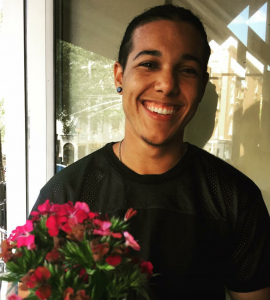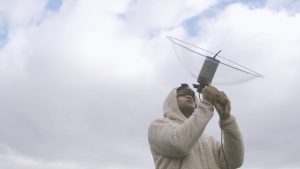In May, EP student Jah Elyse Sayers wrote an essay titled “to be unmade, to be unfinished, to only ever be-with” to accompany the film The Smallest Unit is Each Other (Jonathan González, 2021). The film is currently playing as part of González’s exhibit at the Project Room at BRIC House until May 8, 2022, and can also be viewed online (Click here).
“The smallest unit is each other”: a radical declaration in itself and an opening to the imperative to refuse to see or be any smaller. It is a potent poetic formulation with the potential to color reading, assessment, action—a lens for a worldview. In the 35 minutes following the 10-second holding of the title, this declaration, The Smallest Unit is Each Other, on the screen, Jonathan González constructs a six-sided film through which to breathe life into this declaration. While González names the sides as “like a cassette,” we might imagine a living hexahedron, six sides coordinated into angular and mobile relations. If “abolition geography starts with the homely premise that freedom is a place,” this hexahedral space traces out freedom’s infrastructure and offers many openings to step inside (Gilmore, 2017, p. 227). The flexibility and spaciousness that González coordinates move with the ongoingness of Black radical tradition, most centrally responding to Sylvia Wynter’s calls for a transformed humanity by way of the Third Event, or our reflexive evolution as a species through intentional telling of new stories . Per Wynter’s vividly transdisciplinary theorizing, it is our stories that make us, down to the synapses. She names the storyteller’s imperative as being to “come to know/think/feel/behave and subjectively experience ourselves… in quite different terms” (Wynter & McKittrick, 2015, p. 45). The Smallest Unit is Each Other holds open a space for feeling out, thinking through, and beginning or renewing a commitment to experiencing ourselves, that is being, differently, by only ever being-with.”
References
Gilmore, R. W. (2017). Abolition Geography and the Problem of Innocence. In Futures of Black Radicalism. Verso.
Wynter, S., & McKittrick, K. (2015). Unparalleled Catastrophe for our Species? Or, to Give Humaness a Different Future: Conversations. In Sylvia Wynter: On being human as praxis (pp. 9–89). Duke University Press.
Jonathan González (they/them) is an educator, cultural organizer, farmer, and artist at the intersections of performance and time-based media. Their recent projects and collaborations include those at MoMA, MoMA PS1, Abrons Arts Center Performance Space New York, and Danspace Project, all NY; and Paragon Arts Gallery, Portland, OR. They have done residencies and Fellowships at BRIC, LMCC, NARS, Jerome Foundation, Mertz Gilmore, Art Matters, and Performance Art/Theater Foundation for Contemporary Arts. González holds an MFA from Sarah Lawrence College.

Jah Elyse Sayers (they/them) is a doctoral student in Environmental Psychology. They use poetic and participatory methods to study the ways queer and trans Black, indigenous, and people of color (QTBIPOC) make and maintain place and the factors that support QTBIPOC placemaking. They frequently work with ideas of belonging, disposability, histories, and futurity whether they are crafting clocks from scrap metal; facilitating Afrofuturism workshops; making performance art; or researching the ways QTBIPOC turn pathologized and discarded geographies into sites of home, dreaming, scheming and liberation.


